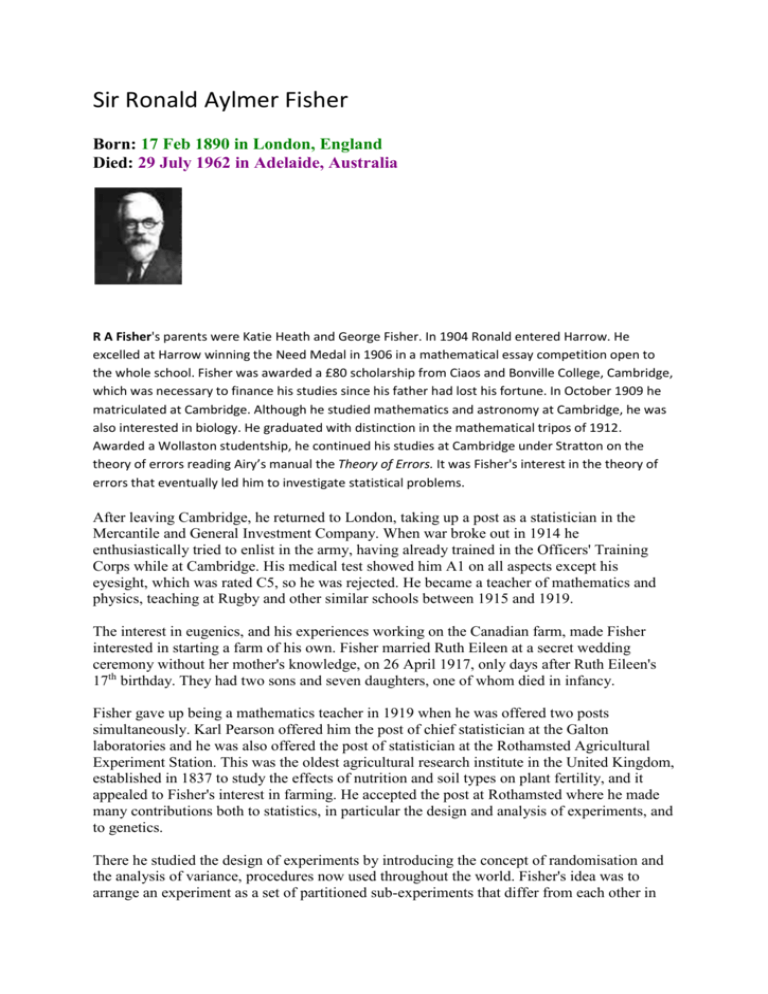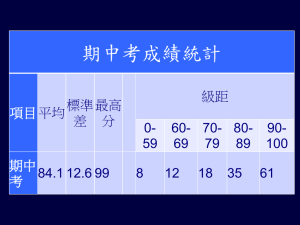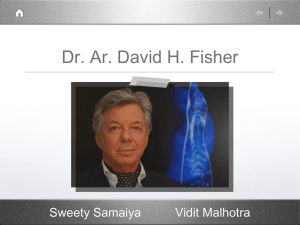Sir Ronald Aylmer Fisher
advertisement

Sir Ronald Aylmer Fisher Born: 17 Feb 1890 in London, England Died: 29 July 1962 in Adelaide, Australia R A Fisher's parents were Katie Heath and George Fisher. In 1904 Ronald entered Harrow. He excelled at Harrow winning the Need Medal in 1906 in a mathematical essay competition open to the whole school. Fisher was awarded a £80 scholarship from Ciaos and Bonville College, Cambridge, which was necessary to finance his studies since his father had lost his fortune. In October 1909 he matriculated at Cambridge. Although he studied mathematics and astronomy at Cambridge, he was also interested in biology. He graduated with distinction in the mathematical tripos of 1912. Awarded a Wollaston studentship, he continued his studies at Cambridge under Stratton on the theory of errors reading Airy’s manual the Theory of Errors. It was Fisher's interest in the theory of errors that eventually led him to investigate statistical problems. After leaving Cambridge, he returned to London, taking up a post as a statistician in the Mercantile and General Investment Company. When war broke out in 1914 he enthusiastically tried to enlist in the army, having already trained in the Officers' Training Corps while at Cambridge. His medical test showed him A1 on all aspects except his eyesight, which was rated C5, so he was rejected. He became a teacher of mathematics and physics, teaching at Rugby and other similar schools between 1915 and 1919. The interest in eugenics, and his experiences working on the Canadian farm, made Fisher interested in starting a farm of his own. Fisher married Ruth Eileen at a secret wedding ceremony without her mother's knowledge, on 26 April 1917, only days after Ruth Eileen's 17th birthday. They had two sons and seven daughters, one of whom died in infancy. Fisher gave up being a mathematics teacher in 1919 when he was offered two posts simultaneously. Karl Pearson offered him the post of chief statistician at the Galton laboratories and he was also offered the post of statistician at the Rothamsted Agricultural Experiment Station. This was the oldest agricultural research institute in the United Kingdom, established in 1837 to study the effects of nutrition and soil types on plant fertility, and it appealed to Fisher's interest in farming. He accepted the post at Rothamsted where he made many contributions both to statistics, in particular the design and analysis of experiments, and to genetics. There he studied the design of experiments by introducing the concept of randomisation and the analysis of variance, procedures now used throughout the world. Fisher's idea was to arrange an experiment as a set of partitioned sub-experiments that differ from each other in having one or several factors or treatments applied to them. The sub-experiments were designed in such a way as to permit differences in their outcome to be attributed to the different factors or combinations of factors by means of statistical analysis. This was a notable advance over the existing approach of varying only one factor at a time in an experiment, which was a relatively inefficient procedure. In 1921 he introduced the concept of likelihood. The likelihood of a parameter is proportional to the probability of the data and it gives a function which usually has a single maximum value, which he called the maximum likelihood. In 1922 he gave a new definition of statistics. Its purpose was, he claimed, the reduction of data, and he identified three fundamental problems. These are: i. ii. iii. specification of the kind of population that the data came from; estimation; and distribution. Fisher published a number of important texts; in particular Statistical Methods for Research Workers (1925) ran to many editions which he extended throughout his life. It was a handbook for the methods for the design and analysis of experiments which he had developed at Rothamsted. The contributions Fisher made included the development of methods suitable for small samples, like those of Gosset, and the discovery of the precise distributions of many sample statistics. Fisher published the design of experiments (1935) and Statistical tables (1947). While at the Agricultural Experiment Station he had conducted breeding experiments with mice, snails and poultry, and the results he obtained led to theories about gene dominance and fitness which he published in The Genetical Theory of Natural Selection (1930). This work on natural selection led Fisher to question the way that in civilised society’s weak and relatively infertile people obtained advantages over strong healthy individuals. He felt that the natural survival of the fittest method of improving the human race was being artificially changed by factors that specifically benefited the less well adapted. A strong advocate of measures to counter this trend, he proposed that family allowances should be proportional to income to support the well-adapted healthy members of society. As one might expect, this policy was very unpopular and he found few supporters. In 1933 Karl Pearson retired as Galton Professor of eugenics at University College and Fisher was appointed to the chair as his successor. Fisher held this post for ten years, being appointed as Arthur Balfour professor of genetics at the University of Cambridge in 1943. Before this, however, he had moved away from London when war broke out in 1939, finding temporary accommodation at Sharpened. He retired from his Cambridge chair in 1957 but continued to carry out his duties there for another two years until his successor could be appointed. He then moved to the University of Adelaide where he continued his research for the final three years of his life. In 1918 Fisher submitted his very important paper on the correlation between relatives on the supposition of MendeliIan inheritance to the Royal Society. Two referees, R C Punnet and Pearson, were appointed and reported on the paper. Neither referee rejected the paper; however, they both merely expressed reservations and stated clearly that there were aspects of the paper that they were not competent to judge. In the event Fisher withdrew the paper and submitted it to the Transactions of the Royal Society of Edinburgh where it was accepted. It is not surprising that Fisher's novel ideas took time to become accepted. Fisher was elected a Fellow of the Royal Society in 1929, was awarded the Royal Medal of the Society in 1938, and was awarded the Darwin Medal of the Society in 1948:He was elected to the American Academy of Arts and Sciences in 1934, the American Philosophical Society in 1941, the International Society of Haematology in 1948, the National Academy of Sciences of the United States in 1948, and the Deutsche Akademie der Naturforscher Leopoldina in 1960. Various institutions awarded him an honorary degree including Harvard University (1936), University of Calcutta (1938), University of London (1946), University of Glasgow (1947), University of Adelaide (1959), University of Leeds (1961), and the Indian Statistical Institute (1962). He was knighted in 1952. Fisher's character is describedas follows:- He was capable of tremendous charm, and warmth in friendship. But he also was the victim, as he himself recognised, of an uncontrollable temper; and his devotion to scientific truth as he saw it being literally passionate, he was an implacable enemy of those whom he judged guilty of propagating error. He had other strengths and weaknesses too: - As a penetrating thinker Fisher was outstanding; but his writings are difficult for many readers. Indeed, some of his teachings have been most effectively conveyed by the books of others who have been able to simplify their expression. As a lecturer also, Fisher was too difficult for the average student; his classes would rapidly fall away until only two or three students who could stand the pace remained as fascinated disciples. Nor was he particularly successful as an administrator; he perhaps failed to appreciate the limitations of the ordinary man. But with his wide interests and penetrating mind he was a most stimulating and sympathetic conversationalist. R. A. Fisher and Modern Statistics Introduction Ronald Fisher undoubtedly laid the foundation for modern statistical methods and their application. His work contributed to statistics to become and develop in an independent scientific discipline. His work on statistical inference on the basis of small sample and the design of experiments is considered outstanding. At the beginning Fisher's work was a little accepted anywhere except England. In the 1950s American academic statisticians were more impressed by the work of Neyman and Wald. Later on, Bayesian statistics was drawing more attention in the specific field of application. In the latter part of the 20th century Fisher's influence was overshadowed by the introduction of computers in statistics. However, his work had numerous followers and the number of critics were not insignificant. As distinguished from many other theorists, he was strongly attached to the statistical application. Statistical thought has continued to develop by the introduction of innovations in the theory and application. Many scientists, aware of the deficiency in Fisher's methods, made an effort to make them better by relying on new scientific achievements. Generally speaking, Fisher's ideas still have a strong impact on statistical theory. Efron (1998) and some other authors speculated about the future of Fisherian statistics in the light of new technological era. Recent development A great contribution of R. A. Fisher is the development of likelihood as a fundamental concept of making inference about the state of system based on the outcome of a set of experiments of trials. Nowadays, computationally intensive algorithms make possible wider application of this method and the development of new techniques. Expectation Maximization (EM) iterative algorithm is a statistical technique for maximizing complex likelihood and handling incomplete data problem developed by Dempster et al. (1977). It may be successfully applied in solving Genomic example (Fisher et Balmukand, 1928) it may be applied in estimation mixtures of distributions that occur in many modern areas as pattern recognition and data mining. Also, many problems of classification may be converted to estimation problem. Fisher’s papers on discriminant analysis inspired Anderson to research in the area of Multivariate analysis and to write his famous book (1984 ). 3. Extreme value theory Extreme value theory (EVT) (Embrechts et al., 1997, Mladenovi_, 2002) has been one of the most quickly developing areas of mathematical statistics in the last decades. EVT deals with asymptotic behaviour of extreme order statistics of a random sample, such as the maximum and the minimum. It has found many applications in different are as: engineering, material strength, oceanography, hydrology, pollution studies, meteorology, financial econometrics, especially in risk management and computation of Value at Risk. Most statisticians aim to characterize typical behaviour and focus on the center of data. EVT aims to characterize rare events and tails of distribution. The theorem of Fisher and Tippett (1928) is the core of this theory. The assertion of this theorem is “limiting forms of the largest and the smallest observation in a sample of given size are few and comparatively simple, although with a normal distribution they are approached exceedingly slowly”. Fisher deduced the possible limiting forms from the functional relation which they must satisfy. The theorem suggests that asymptotic distribution of the maximum belongs to one of three distributions regardless of the original data: (1) G1(x) exp(ex ) , -x , (2) G2(x) exp(x) , x 0 , 0 , (3) G3(x) exp((x)) , x 0, 0 . Extreme value distribution G1(x) is Gumbel distribution that has a right tail no thicker than exponential distribution; G2(x) is Fréchet distribution that exhibits the right tail that declines by a power and G3(x) is Weibul distribution with finite upper limit. Gnedenko (1943) continued Fisher’s research in this area and made EVT more rigorous by giving necessary and sufficient conditions for weak convergence of order statistics. Nowadays modelling extreme events through heavy-tailed distributions attracts more and more attention. The number of statisticians working in extreme value methodology and its application, and the number of publications in this area are growing.




